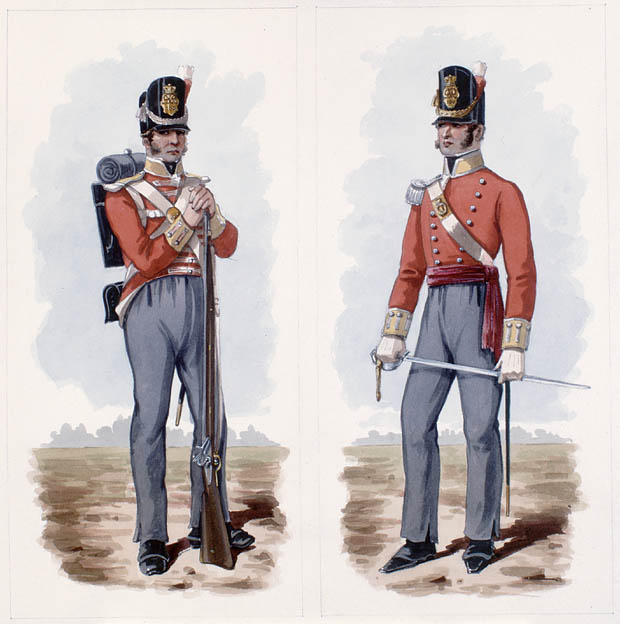Our sites:
Home
of
Access Heritage Inc (formerly The Discriminating General)
The Napoleonic Wars Collection
Military Music Sound Clip Gallery
Products and Services:
British Army Products 1793-1815
British Army Products 1816-1856

Articles - Reenactments and Units - Book Reviews - Quizzes - Replicas - Links - Chart of British Regiments - Sound Clips - Prints for Sale - Animated GIF Battles - Chronology of Events - Video Clips
The Storming of Fort
Niagara, December 18, 1813
by Robert Henderson
Officer, New York State Militia, 1813 by H.C.
McBarron
(courtesy of Parks Canada)
By the end of 1813 the majority of US regulars had been drawn away from the Niagara frontier for Major General James Wilkinson’s expedition to capture Montreal. Efforts by Brigadier General George Mc Clure to entice militia from New York State to reinforce US positions on the Canadian side of the Niagara river had been meet with disinterest. With British pickets pressing closer and closer Mc Clure in early December saw little choice but to abandon his footing in Canada and retreat across the river to the United States.
Before leaving Mc Clure had to fulfill one order from the Secretary at War John Armstrong: burn the town of Niagara. Over one hundred buildings were put to the touch and over 400 civilians, mostly women and children were forced into the snow without shelter or belongings. It was this act that eventually resulted in the burning of Washington as retribution.
The British under Colonel John Murray quickly took up positions along the shores of the river. On December 17, the newly appointed commander of Upper Canada, Lieutenant General Sir Gordon Drummond, a Canadian by birth, ordered Murray to strike Fort Niagara as soon as possible. A night assault was decided upon and boats were brought 68 km miles overland from Burlington Heights for this purpose. With a force of five hundred consisting of the Grenadiers of the 1st (Royal Scots), 41st, and 100th Regiments along with the 41st Light Company and some militia, Murray was ready. The troops were instructed to be silent as possible and to only use their bayonets, as musket fire would destroy the element of surprise.

100th Regiment of Foot (LAC)
Late at night on December 18 the Anglo-Canadian force crossed the river 5 km above the fort, surprised and captured a piquet at Youngstown and secured the sentry’s countersign for the fort. With scaling ladders in hand, Murray’s force made its way through the dark towards their objective. Shadrach Byfield of the witnessed the subsequent events:
We advanced quietly, and a party under the command of a sergeant went in front. When he came near the outer sentry, at the entrance to the fort, he was challenged; he advanced and gave the countersign, seized the sentinel, and threatened him with immediate death if he made any noise. He then proceeded to the gate, and was challenged by the sentry inside; he gave the countersign and gained admittance but the sentry cried out, "The British - turn out the guard." Our force was fully prepared and in a very short time we had possession of the fort, with very little loss.
For the loss of 6 killed and 5 wounded, Murray’s force of five hundred had killed, wounded or made prisoner 422 officers and men and had captured tons of stores including 27 cannons and 3000 stands of arms. Fort Niagara remained occupied by the British until the end of the war.
Copyright: Access Heritage Inc (formerly The Discriminating General) 1998
© Copyright: Unless otherwise noted, all information, images, data contained within this website is protected by copyright under international law. Any unauthorized use of material contained here is strictly forbidden. All rights reserved.

